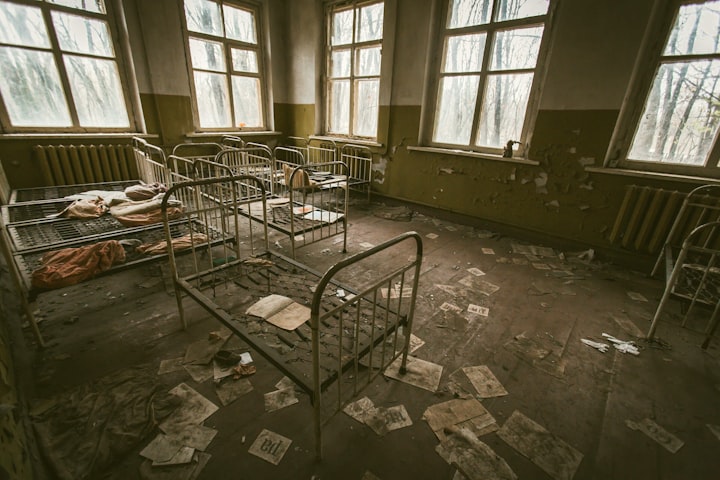10 Creepy Abandoned Hospitals in Europe
Step Inside Europe's Abandoned Hospitals: 10 Chilling Sites of History and Mystery

Hospitals are places many people don’t want to visit. Unless you’re a medical professional, the thought of being in the antiseptic-scented hallways is enough to keep anyone away. However, if you do land in the hospital, you can be assured you’ll be surrounded by caring nurses and crisp, clean bedding.
However, not all hospitals can boast of this. In fact, the ten former medical centers on this list are definitely places you don’t want to end up in… whether injured or healthy. So let’s take a stroll through the hallways of these 10 creepy abandoned hospitals in Europe.
10. Brestovac Sanatorium
High on the slopes of Mt. Medvednica, outside of Zagreb, Croatia, stands the ruins of a supposedly haunted sanatorium. Built in the early 20th century, Brestovac was opened to treat one of the most serious illnesses that was affecting Europe at the time—tuberculosis. Also called the “White Plague,” its first patients were admitted in 1909. It operated until 1968 when medical advances meant there was far better treatment for tuberculosis, and many sanatorium facilities were no longer needed.
Brestovac was designed and built by a local man named Milivoj Dezman. He was a medical physician, but this wasn’t actually his main reason for opening the sanatorium.
A Croatian actress named Ljerka Sram was very popular at the time, and Milivoj knew her from his childhood. Eventually, they lost contact, but upon seeing her acting for the first time, he fell desperately in love. Despite promising to wait for him to finish his medical studies, she married another man.To cope, Milivoj began writing plays with Ljerka in mind for the main role. Eventually, her husband left her, and she moved in with Milivoj.
Unfortunately, Milivoj did not get to live his dreams for long. Shortly after moving in, Ljerka developed tuberculosis. Once again showing his devotion, Milivoj used his leverage in his profession to create Brestovac Sanatorium, where he hoped he would be able to cure Ljerkas’s ailment. Despite Milivoj’s close care and treatment, Ljerka died in late 1913, aged 39. It has been said that she died in his arms.
9. Beelitz Heilstatten
Just outside of Berlin is a hospital that opened 121 years ago and was left to rot for the last 25.Beelitz was originally the largest hospital in the world for lung-related issues. It boasted 60 buildings over 494 acres (200 hectares) of landscaped gardens. During the first 25 years the hospital operated, it treated over 110,000 patients. During WWI, it was used as a military hospital.
After the war, it was left abandoned for some time before being used as a military hospital again in WWII. It was eventually captured and occupied by the Soviet army for 50 years, only to finally be abandoned for good in 1995. Some parts of the hospital have been re-opened and repurposed, but the majority of the buildings are still in a state of ruin.
8. Zofiówka Sanatorium
Zofiówka Sanatorium was founded in 1908 by the Society for the Protection of Mentally Ill Jews, built with funds donated by Zofia Endelman.
Its original use was as a sanatorium for Polish Jews with psychological issues. Built on 74 acres (30 hectares) of land, it employed 994 staff at its busiest point. It made use of the more modern practices being developed at the time, like electroshock therapy; however, it eventually became used for even more sinister purposes.
Zofiowka ended up being the only Jewish psychiatric facility in the entirety of occupied Poland. Conditions were atrocious, with disease and starvation killing most of the patients—210, to be exact. After this, it was used to raise Polish children as a way to assimilate them.
Eventually, the war ended, and the hospital was deserted. Over time, it has been repurposed to treat tuberculosis, addicts, and youth with psychological conditions before being closed forever in the mid-1990s.
7. Mombello Sanatorium
In Limbiate, not far from Milan, are the ruins of the Mombello Psychiatric Hospital, also known as Giuseppe Antonini Psychiatric Hospital, after its most influential director. The site of the hospital covers nearly 10 acres (4 hectares) and can be traced back to the early Middle Ages when it was built originally as a fortress.
Established in 1865, it served to replace Milan’s main psychiatric hospital. The first patients, 300 of them, were transferred over in 1867. Over time, it became the largest psychiatric facility in the region, and when Senavre finally closed its doors in 1878, patient numbers exceeded 1,000.During WWI, The former psychiatric facility assigned two wards to soldiers traumatized by their time at war. After asylums in Venice were closed down, a ward was constructed for the displaced Venetians, and it was used to house WWII refugees.Today, the structures are in ruin and have been heavily vandalized, with all valuables from the site being stolen long ago.
6. Sanatorio de Mont’ lto
Also known as Sanatorio de Valongo, it was built during the Estado Novo era in São Pedro da Cova in Portugal. The sanatorium only operated from 1958 to 1975 and has been abandoned since.In 1899, the Portuguese queen established the National Institute of Assistance to Tuberculosis, leading to the birth of a few sanatoriums in the area, including Moltalto. Construction didn’t begin until 1932, though, and the hospital wasn’t finished for another 25 years.
Tuberculosis became much easier to treat by the time the ’70s came, and very few patients were left. Initially, they had hoped to repurpose it as a psychiatric hospital, but it never came to fruition. The site was soon looted and eventually mostly destroyed by fire. More recently, suggestions were made to refurbish the building as a youth hostel, but once again, these plans never came through.
5. Heilstatte Grabowsee
A large complex of 30 buildings lay across the site at Grabowsee, north of Berlin in Germany. It began its life as a test facility to see whether the clean country air contributed to the treatment of respiratory issues. Once tests proved their theories to be correct, the hospital grew to house 300 patients.
It was established by the German Red Cross in 1896, its most recent occupants being the Soviet army, who utilized it as a military hospital. The site has been completely abandoned since reunification. Like most sanatorium sites, there has been no attempt to conserve the structures, and everything of value has been removed while the buildings crumble and nature slowly closes in around them.
4. Sanatoria Sierra Espuna
The sanatorium of Sierra Espuna is located in Murcia, Spain. It was originally built as a quarantine center in the early 1900s to segregate leprosy and tuberculosis patients from the healthy population. The clean air of the Sierra was considered to be the best treatment available at the time. Building began in 1913 but did not conclude until 1931.
The hospital, at its maximum capacity, housed 200 patients and up to 50 employees. Then, in 1943, streptomycin was discovered, leading to rapid changes in tuberculosis treatment, and many of the patients who had previously suffered from respiratory issues were released. The remaining were transferred to a different hospital, and the Sierra was turned into an orphanage.
By 1961, the orphanage was abandoned due to issues with funding, and the property has been surrounded by eerie tales of ghosts ever since. There was an attempt to convert the buildings into a youth hostel, but the low budget meant only one wing was refurbished, and the location didn’t attract many tourists.
3. Khovrinskaya Hospital
Often referred to as the Umbrella Building (due to its uncanny resemblance to the Umbrella building in Resident Evil), Moscow’s Khovrinskata Hospital began construction in 1980. However, construction was halted in 1985 due to poor terrain, having been placed on a swamp where the lower floors of the building flooded. According to old maps of the area, it was also the site of a cemetery.
The hospital was intended to house up to 1,300 patients and covered 6 acres (2.4 hectares) of land. For a time, rescue service personnel trained here. For a long time, it attracted looters and vandals, and eventually, it was placed under heavy guard.
2. Sanatorium Energy

Said to be haunted, Sanatorium Energy Russia also has a dark history. Construction began in 1963, and it remained in operation until 2009. One day, one of the buildings burned down, and 12—possibly more—patients died in the fire. The only thing left over from the fire is the bare structure of the building and a set of free-standing palace stairs.
These days, there is another newer building on the site of the sanatorium, a small boarding house for tourists to stay in. Most of the abandoned parts have been at least semi-demolished, but there are still walls and foundations scattered throughout the site. The area is still very popular for fishing and swimming, and these ruins have become a part of everyday life for the locals.
1. Abbots Sanatorium
Located in Tenerife on the Canary Islands, Abbots Sanatorium was a refuge for thousands of leprosy patients over the years. The Canary Islands ran rife with infectious diseases, aided by its tropical climate and poverty rates. While leprosy never hit the pandemic level in the Canary Islands, there was still a major cause for alarm, and most lepers were condemned to live in isolation.
The Cabildo instilled quarantine measures and planned the construction of a shelter for the patients living in isolation. Over the course of years, the project expanded, and patients were sent to the Hospital de San Lazaro in Gran Canaria—ominously known as the “Valley Of Death.”
Unfortunately, there was little control on the island, which led to more infections, and Tererife officially became the highest carrier of leprosy in the area, housing about 500 patients in the ’70s.
Designed by Jose Enrique Regalado Marrero, it was in 1943 that the construction of the Sanatorium de Abades began. However, by this time, medicine had advanced, and there was already a cure for leprosy. It was a huge complex of over 40 buildings, including a school and crematorium. The fact that quite a large sum of money was invested in constructing a leper colony at a time when the WHO was suggesting they be closed is quite a mystery.
Unsurprisingly, the sanatorium never received any leprosy patients. It was used briefly as a military site and now sits abandoned in the middle of the island. It is now owned by a private contractor who intends to develop the site.






Comments
There are no comments for this story
Be the first to respond and start the conversation.